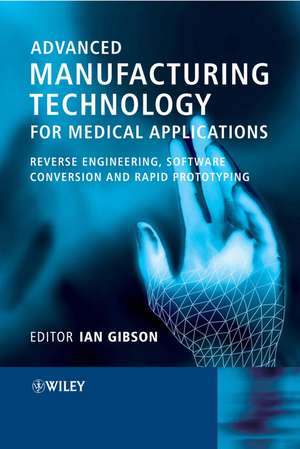Advanced Manufacturing Technology for Medical Applications – Reverse Engineering, Software Conversion and Rapid Prototyping: Engineering Research Series (REP)
Autor I Gibsonen Limba Engleză Hardback – 3 noi 2005
Preț: 679.40 lei
Preț vechi: 998.78 lei
-32% Nou
Puncte Express: 1019
Preț estimativ în valută:
129.100€ • 136.10$ • 107.57£
129.100€ • 136.10$ • 107.57£
Carte indisponibilă temporar
Doresc să fiu notificat când acest titlu va fi disponibil:
Se trimite...
Preluare comenzi: 021 569.72.76
Specificații
ISBN-13: 9780470016886
ISBN-10: 0470016884
Pagini: 254
Dimensiuni: 172 x 244 x 17 mm
Greutate: 0.62 kg
Editura: Wiley
Seria Engineering Research Series (REP)
Locul publicării:Chichester, United Kingdom
ISBN-10: 0470016884
Pagini: 254
Dimensiuni: 172 x 244 x 17 mm
Greutate: 0.62 kg
Editura: Wiley
Seria Engineering Research Series (REP)
Locul publicării:Chichester, United Kingdom
Public țintă
Primary: Medical practitioners in bone surgery disciplines; orthopaedics, oral and maxillofacial surgery, dental surgery. Also neurosurgeons and surgeons specialising in conjoined twin separation. Prosthetic device system developers. Medical engineering researchers and educators. Secondary: Those generally interested in medical engineering developments. Manufacturing, industrial and mechanical engineers.Cuprins
Contributors.
1. Rapid Prototyping for Medical Applications (Ian Gibson).
1.1 Overview.
1.2 Workshop on Medical Applications for Reverse Engineering and Rapid Prototyping.
1.3 Purpose of this Chapter (Overview).
1.4 Background on Rapid Prototyping.
1.5 Sterolithography and Other Resin-type Systems.
1.6 Fused Deposition Modelling and Selective Laser Sintering.
1.7 Droplet/Binder Systems.
1.8 Related Technology: Microsystems and Direct Metal Systems.
1.9 File Preparation.
1.10 Relationship with Other Technologies.
1.11 Disadvantages with RP for Medical Applications.
1.12 Summary.
Bibliography.
2. Role of Rapid Digital Manufacture in Planning and Implementation of Complex Medical Treatments (Andrew M. Christensen and Stephen M. Humphries).
2.1 Introduction.
2.2 Primer on Medical Imaging.
2.3 Surgical Planning.
2.4 RDM in Medicine.
2.5 The Future.
2.6 Conclusion.
References.
3. Biomodelling (P. D'Urso).
3.1 Introduction.
3.2 Surgical Applications of Real Virtuality.
3.3 Case Studies.
References.
4. Three-dimensional Data Capture and Processing (W. Feng, Y. F. Zhang, Y. F. Wu and Y. S. Wong).
4.1 Introduction.
4.2 3D Medical Scan Process.
4.3 RE and RP in Medical Application.
4.4 Applications of Medical Imaging.
4.5 Case Study.
4.6 Conclusions.
References.
Bibliography.
5. Software for Medical Data Transfer (Ellen Dhoore).
5.1 Introduction.
5.2 Medical Imaging: from Medical Scanner to 3D Model.
5.4 Conclusions.
Bibliography.
6. BioBuild Software (Robert Thompson and Dr Gian Lorenzetto).
6.1 Introduction.
6.2 BioBuild Paradigm.
6.3 Future Enhancements.
6.4 Conclusion.
References
7. Generalized Artificial Finger Joint Design Process Employing Reverse Engineering (I. Gibson and X. P. Wang).
7.1 Introduction.
7.2 Supporting Literature.
7.3 Technological Supports for the Prosthesis Design.
7.4 Proposed Methodology.
7.5 Finger Joint Surface Modelling and Feature Extraction.
7.6 Database Construction and Surface Generalization.
7.7 Conclusions.
References.
8. Scaffold-based Tissue Engineering - Design and Fabrication of Matrices Using Solid Freeform Fabrication Techniques (Dietmar W. Hutmacher).
8.1 Background.
8.2 Introduction.
8.3 Systems Based on Laser and UV Light Sources.
8.4 Systems Based on Printing Technology.
8.5 Systems Based on Extrusion/Direct Writing.
8.6 Indirect SFF.
8.7 Robotic and Mechatronically Controlled Systems
8.8 Conclusions.
References.
9. Direct Fabrication of Custom Orthopedic Implants Using Electron Beam Melting Technology (Ola L. A. Harrysson and Dennis R. Cormier).
9.1 Introduction.
9.2 Literature Review.
9.3 Electron Beam Melting Technology.
9.4 Direct Fabrication of Titanium Orthopedic Implants.
9.5 Summary and Conclusions.
References.
10. Modelling, Analysis and Fabrication of Below-knee Prosthetic Sockets Using Rapid Prototyping (J. Y. H. Fuh, W. Feng and Y. S. Wong).
10.1 Introduction.
10.2 Computer-facilitated Approach.
10.3 Experiments.
10.4 Results and Discussion.
10.5 Rapid Socket Manufacturing Machine (RSMM).
10.6 Conclusions.
Acknowledgements.
References.
Bibliography.
11. Future Development of Medical Applications for Advanced Manufacturing Technology (Ian Gibson).
11.1 Introduction.
11.2 Scanning Technology.
11.3 RP Technology.
11.4 Direct Manufacture.
11.5 Tissue Engineering.
11.6 Business.
Index.
Notă biografică
Ian Gibson is the editor of Advanced Manufacturing Technology for Medical Applications: Reverse Engineering, Software Conversion and Rapid Prototyping, published by Wiley.
Descriere
This book covers a range of applications where advanced manufacturing technology can be applied to medical procedures. Early chapters look at the reverse engineering process, where patient data is converted into a machine-readable format to allow users to create system solutions to medical problems.







